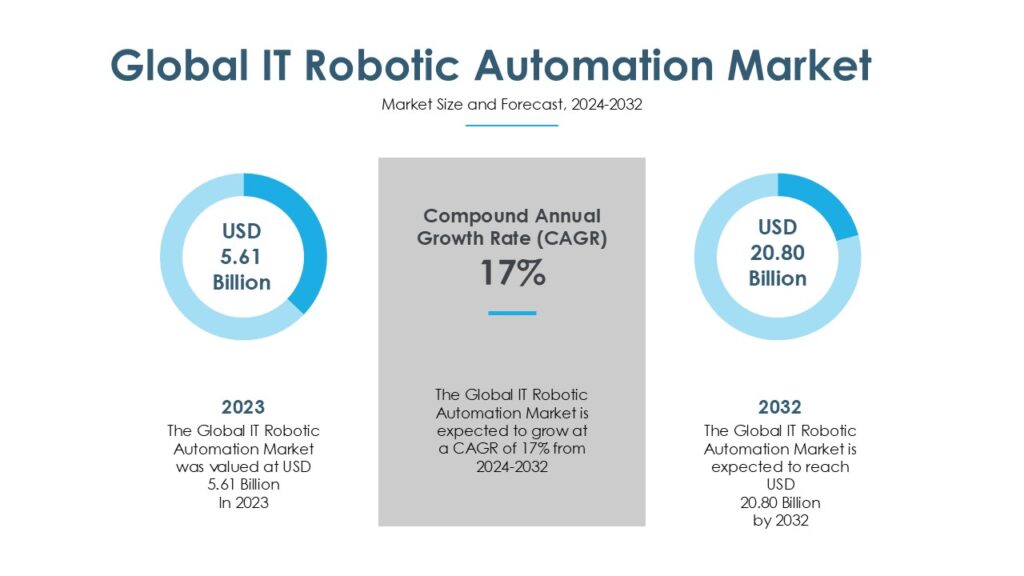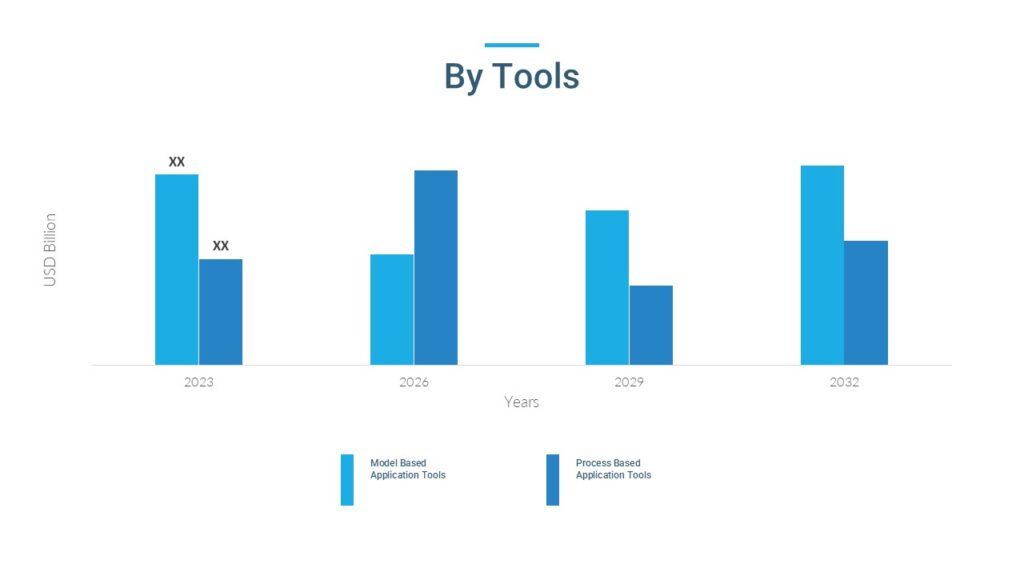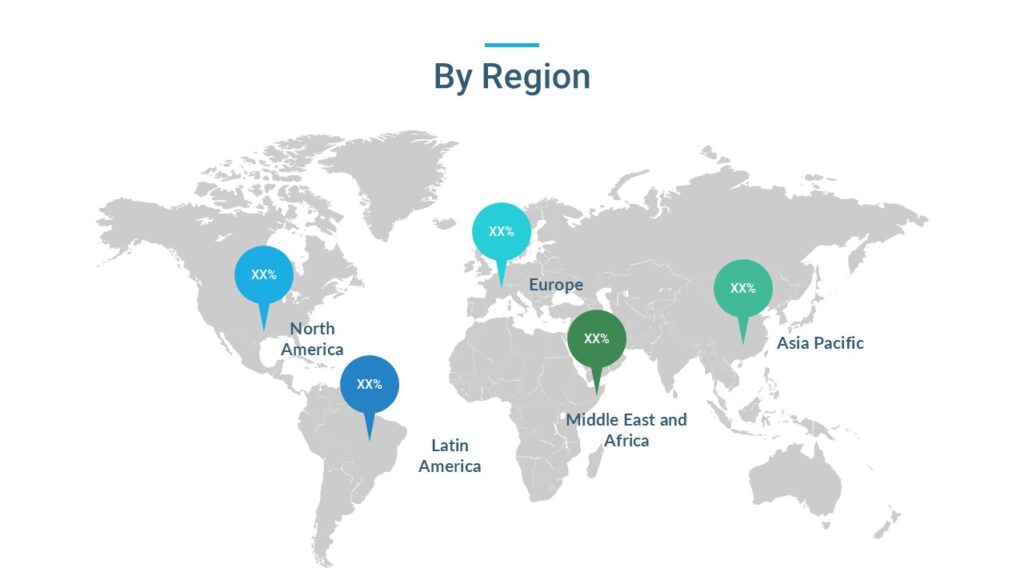
Global IT Robotic Automation Market "(By Solutions: Tools and Services; By Tools: Model-based Application Tools, Process-based Application Tools; By Services: Professional Consulting, Integration & Development, BPO & Training; By Region: North America, Europe, Asia Pacific, Latin America, and Middle East and Africa)”- Global Industry Analysis, Size, Share, Growth, Trends, And Forecast, 2024-2032
- Category: ICT, Automation and Semiconductor
- Report ID: CMR33919
- Published Date:
A prominent research firm, Cognizance Market Research added a cutting-edge industry report on the “Global IT Robotic Automation Market”. The report studies the current and past growth trends and opportunities for the market to gain valuable insights during the forecast period from 2023 to 2032.
Global IT Robotic Automation Market Analysis:
According to cognizance market research, the global IT robotic automation market was valued at US$ 5.61 Billion in 2023 and is anticipated to reach US$ 22.80 Billion by the end of 2032 with a CAGR of 17% from 2023 to 2032.

What is the Global IT Robotic Automation Market?
The Global IT Robotic Automation Market refers to the adoption of software solutions that automate repetitive, rule-based tasks traditionally performed by humans. The solutions include Robotic Process Automation (RPA) and intelligent automation, both helping businesses enhance operational efficiency while reducing errors and saving costs by mimicking human actions in digital workflows.
It covers all sectors, such as banking, healthcare, retail, and telecommunication, in which automation is vital to carry out high-volume workloads such as data entry, customer support, and generating reports. The fusion of AI and ML in RPA has opened up their functionality and expanded their capabilities in taking up complex processes requiring decision-making and analytics.
It is growing fast in the market through increasing demand for digital transformation, scalability, and cost efficiency. Growing demands and the increasing adoption of cloud-based automation solutions are promoting it in all areas with improvements in technologies such as AI and 5G.
Global IT Robotic Automation Market Outlook:
The Global IT Robotic Automation Market will witness significant growth with increasing requirements for automation. Automation brings efficiency and reduction in the cost of operations into business models. Businesses worldwide are adapting to robotic process automation fast to automate repeat processes.
Technological innovation in AI and ML, among others, has continued to increase the scope of RPA solutions. This way, the systems are empowered to handle more complex operations like decision-making and data analysis, hence increasing their value to the organization.
A significant trend shaping the market outlook is the shift toward cloud-based automation platforms. Scalability, flexibility, and cost-effectiveness are offered by cloud RPA solutions, which makes them more attractive to SMEs.
North America leads the market because of its developed IT infrastructure and wide acceptance of digital transformation initiatives. The Asia-Pacific region, however, is growing the fastest due to rapid industrialization and investment in technology.
Sector-specific solutions are emerging as people seek industry-specific automation solutions, including banking, healthcare, and retail industries. Industry-specific solutions help companies deal with specific issues and streamline processes in a particular sector.
The market, despite growth, is not without challenges. There are cybersecurity risks and integration complexities. Businesses are looking for vendors that provide secure and user-friendly solutions to overcome these barriers in an effective manner.
Segment Analysis:
The IT Robotic Automation Market is categorized based on component, application, and end-user industry. It is divided into software which includes RPA platforms and intelligent automation tools and services which include consulting, implementation, and support. Software leads the segment as more advanced RPA solutions with AI and machine learning capabilities gain traction. Services are essential to deploy and optimize automation systems.

By application, the market is widely used in back-office automation, customer service, and IT operation management. This market remains the most significant by way of back-office automation due to its high potential for efficiency gains. The end-user industries mainly include banking and financial services, followed by healthcare, retail, and telecom. Each industry applies robotic automation to overcome particular problems like compliance, cost cutting, and process optimization that testify to the flexibility and wide appeal of such solutions.


Geographical Analysis:
North America leads the IT Robotic Automation Market with its advanced technological infrastructure, large-scale digital transformation initiatives, and early adoption of RPA. The United States is the major contributor in this region, as demand from different industries is high which makes their processes efficient and cost-effective.
Europe is another prominent region and the country heads are Germany, the UK, and France, which leads in adoption. Industry 4.0 and manufacturing automation are huge growth drivers. Europe also has regulations supporting the deployments of safe and compliant automation solutions in such as sectors finance and health care.

Asia-Pacific is the fastest-growing region in the IT robotic automation market, driven by rapid industrialization, increasing IT investment, and government support for technology adoption. Countries like China, India, and Japan are using RPA to improve productivity and reduce labor costs, especially in manufacturing, telecommunication, and e-commerce.
The report offers the revenue of the Global IT Robotic Automation Market for the period 2020-2032, considering 2020 to 2022 as a historical year, 2023 as the base year, and 2024 to 2032 as the forecast year. The report also provides the compound annual growth rate (CAGR) for the Global IT Robotic Automation Market for the forecast period. The Global IT Robotic Automation Market report provides insights and in-depth analysis into developments impacting enterprises and businesses on a regional and global level. The report covers the Global IT Robotic Automation Market performance in terms of revenue contribution from several segments and comprises a detailed analysis of key drivers, trends, restraints, and opportunities prompting revenue growth of the Global IT Robotic Automation Market.
The report has been prepared after wide-ranging secondary and primary research. Secondary research included internet sources, numerical data from government organizations, trade associations, and websites. Analysts have also employed an amalgamation of bottom-up and top-down approaches to study numerous phenomena in the Global IT Robotic Automation Market. Secondary research involved a detailed analysis of significant players’ product portfolios. Literature reviews, press releases, annual reports, white papers, and relevant documents have been also studied to understand the Global IT Robotic Automation Market. Primary research involved a great extent of research efforts, wherein experts carried out interviews telephonic as well as questioner-based with industry experts and opinion-makers.
The report includes an executive summary, along with a growth pattern of different segments included in the scope of the study. The Y-o-Y analysis with elaborate market insights has been provided in the report to comprehend the Y-o-Y trends in the Global IT Robotic Automation Market. Additionally, the report focuses on altering competitive dynamics in the global market. These indices serve as valued tools for present market players as well as for companies interested in participating in the Global IT Robotic Automation Market. The subsequent section of the Global IT Robotic Automation Market report highlights the USPs, which include key industry events (product launch, research partnership, acquisition, etc.), technology advancements, pipeline analysis, prevalence data, and regulatory scenarios.
Global IT Robotic Automation Market Competitive Landscape:
There are several small and major firms participating in the highly fragmented Global IT Robotic Automation Market. The new strategies formed by companies revolve around accuracy and precision. The following are some of the major market participants:
- Blue Prism Group
- UiPath Inc.
- Automation Anywhere Inc.
- WorkFusion
- NICE Ltd
- Kofax Inc.
- Pegasystems
- SAP SE
- Microsoft Corporation
The report explores the competitive scenario of the Global IT Robotic Automation Market. Major players working in the Global IT Robotic Automation Market have been named and profiled for unique commercial attributes. Company overview (company description, product portfolio, geographic presence, employee strength, Key management, etc.), financials, SWOT analysis, recent developments, and key strategies are some of the features of companies profiled in the Global IT Robotic Automation Market report.
Segmentation:
Global IT Robotic Automation Market, By Solutions:
- Tools
- Services
Global IT Robotic Automation Market, By Tools:
- Model-Based Application Tools
- Process-Based Application Tools
Global IT Robotic Automation Market, By Services:
- Professional Consulting
- Integration & Development
- BPO & Training
Global IT Robotic Automation Market, by Region:
- North America
- U.S.
- Canada
- Europe
- Germany
- U.K.
- France
- Spain
- Italy
- Rest of Europe
- Asia Pacific
- Japan
- China
- India
- Australia & New Zealand
- South Korea
- Rest of Asia Pacific
- Latin America
- Brazil
- Mexico
- Rest of Latin America
- Middle East & Africa
- GCC
- South Africa
- Rest of the Middle East & Africa
Research Methodology: Aspects
Market research is a crucial tool for organizations aiming to navigate the dynamic landscape of customer preferences, business trends, and competitive landscapes. At Cognizance Market Research, acknowledging the importance of robust research methodologies is vital to delivering actionable insights to our clientele. The significance of such methodologies lies in their capability to offer clarity in complexity, guiding strategic management with realistic evidence rather than speculation. Our clientele seek insights that excel superficial observations, reaching deep into the details of consumer behaviours, market dynamics, and evolving opportunities. These insights serve as the basis upon which businesses craft tailored approaches, optimize product offerings, and gain a competitive edge in an ever-growing marketplace.
The frequency of information updates is a cornerstone of our commitment to providing timely, relevant, and accurate insights. Cognizance Market Research adheres to a rigorous schedule of data collection, analysis, and distribution to ensure that our reports reflect the most current market realities. This proactive approach enables our clients to stay ahead of the curve, capitalize on emerging trends, and mitigate risks associated with outdated information.
Our research process is characterized by meticulous attention to detail and methodological rigor. It begins with a comprehensive understanding of client objectives, industry dynamics, and research scope. Leveraging a combination of primary and secondary research methodologies, we gather data from diverse sources including surveys, interviews, industry reports, and proprietary databases. Rigorous data analysis techniques are then employed to derive meaningful insights, identify patterns, and uncover actionable recommendations. Throughout the process, we remain vigilant in upholding the highest standards of data integrity, ensuring that our findings are robust, reliable, and actionable.
Key phases involved in in our research process are mentioned below:

Understanding Clients’ Objectives:
Extensive Discussions and Consultations:
- We initiate in-depth discussions and consultations with our clients to gain a comprehensive understanding of their objectives. This involves actively listening to their needs, concerns, and aspirations regarding the research project.
- Through these interactions, we aim to uncover the underlying motivations driving their research requirements and the specific outcomes they hope to achieve.
Industry and Market Segment Analysis:
- We invest time and effort in comprehensively understanding our clients’ industry and market segment. This involves conducting thorough research into market trends, competitive dynamics, regulatory frameworks, and emerging opportunities or threats.
- By acquiring a deep understanding of the broader industry landscape, we can provide context-rich insights that resonate with our clients’ strategic objectives.
Target Audience Understanding:
- We analyze our clients’ target audience demographics, behaviors, preferences, and needs to align our research efforts with their consumer-centric objectives. This entails segmenting the audience based on various criteria such as age, gender, income level, geographic location, and psychographic factors.
- By understanding the nuances of the target audience, we can tailor our research methodologies to gather relevant data that illuminates consumer perceptions, attitudes, and purchase intent.

Identifying Challenges and Opportunities:
- We proactively identify the challenges and opportunities facing our clients within their respective industries. This involves conducting SWOT (Strengths, Weaknesses, Opportunities, Threats) analyses and competitive benchmarking exercises.
- By identifying potential obstacles and growth drivers, we can provide strategic recommendations that help our clients navigate complexities and capitalize on emerging opportunities effectively.
Grasping Specific Goals:
- We delve into the intricacies of our clients’ objectives to gain clarity on the specific goals they aim to accomplish through the research. This entails understanding their desired outcomes, such as market expansion, product development, or competitive analysis.
- By gaining a nuanced understanding of our clients’ goals, we can tailor our research approach to address their unique challenges and opportunities effectively.
Data Collection:

Primary Research Process:
- Surveys: We design and administer surveys tailored to capture specific information relevant to our clients’ objectives. This may involve employing various survey methodologies, such as online, telephone, or face-to-face interviews, to reach target audiences effectively.
- Interviews: We conduct structured or semi-structured interviews with key stakeholders, industry experts, or target consumers to gather in-depth insights and perspectives on relevant topics. These interviews allow us to probe deeper into specific issues and uncover valuable qualitative data.
- Focus Groups: We organize focus group discussions with carefully selected participants to facilitate interactive discussions and gather collective opinions, attitudes, and preferences. This qualitative research method provides rich contextual insights into consumer behaviors and perceptions.
- Observations: We conduct observational research by directly observing consumer behaviors, interactions, and experiences in real-world settings. This method enables us to gather objective data on consumer actions and reactions without relying on self-reported information.
Secondary Research Process:
- Literature Review: We conduct comprehensive literature reviews to identify existing studies, academic articles, and industry reports relevant to the research topic. This helps us gain insights into previous research findings, theoretical frameworks, and best practices.
- Industry Reports: We analyze industry reports published by reputable trade associations (whitepapers, research studies, etc.), and government agencies (U.S. Census Bureau, Bureau of Labor Statistics, and Securities and Exchange Commission etc.) to obtain macro-level insights into market trends, competitive landscapes, and industry dynamics.
- Government Publications: We review government publications, such as economic reports, regulatory documents, and statistical databases, to gather relevant data on demographics, market size, consumer spending patterns, and regulatory frameworks.
- Online Databases: We leverage online databases, such as industry portals, and academic repositories (PubMed Central (PMC), ScienceDirect, SSRN (Social Science Research Network), Directory of Open Access Journals (DOAJ), NCBI, etc.), to access a wide range of secondary data sources, including market statistics, financial data, and industry analyses.


Data Analysis:
The data analysis phase serves as a critical juncture where raw data is transformed into actionable insights that inform strategic decision-making. Through the utilization of analytical methods such as statistical analysis and qualitative techniques like thematic coding, we uncover patterns, correlations, and trends within the data. By ensuring the integrity and validity of our findings, we strive to provide clients with accurate and reliable insights that accurately reflect the realities of the market landscape.

Transformation of Raw Data:
- Upon collecting the necessary data, we transition into the data analysis phase, where raw data is processed and transformed into actionable insights. This involves organizing, cleaning, and structuring the data to prepare it for analysis.
Utilization of Analytical Methods:
- Depending on the research objectives, we employ a diverse range of analytical methods to extract meaningful insights from the data. These methods include statistical analysis, trend analysis, regression analysis, and qualitative coding.
Statistical Analysis:
- Statistical tools are instrumental in uncovering patterns, correlations, and trends within the data. By applying statistical techniques such as descriptive statistics, hypothesis testing, and multivariate analysis, we can discern relationships and derive valuable insights.
Qualitative Analysis Techniques:
- In addition to quantitative analysis, we leverage qualitative analysis techniques to gain deeper insights from qualitative data sources such as interviews or open-ended survey responses. One such technique is thematic coding, which involves systematically categorizing and interpreting themes or patterns within qualitative data.
Integrity and Validity Maintenance:
- Throughout the analysis process, we maintain a steadfast commitment to upholding the integrity and validity of our findings. This entails rigorous adherence to established methodologies, transparency in data handling, and thorough validation of analytical outcomes.
Data Validation:
The final phase of our research methodology is data validation, which is essential for ensuring the reliability and credibility of our findings. Validation involves scrutinizing the collected data to identify any inconsistencies, errors, or biases that may have crept in during the research process. We employ various validation techniques, including cross-referencing data from multiple sources, conducting validity checks on survey instruments, and seeking feedback from independent experts or peer reviewers. Additionally, we leverage internal quality assurance protocols to verify the accuracy and integrity of our analysis. By subjecting our findings to rigorous validation procedures, we instill confidence in our clients that the insights they receive are robust, reliable, and trustworthy.

Importance of Data Validation:
- Data validation is the final phase of the research methodology, crucial for ensuring the reliability and credibility of the findings. It involves a systematic process of reviewing and verifying the collected data to detect any inconsistencies, errors, or biases.
Scrutiny of Collected Data:
- The validation process begins with a thorough scrutiny of the collected data to identify any discrepancies or anomalies. This entails comparing data points, checking for outliers, and verifying the accuracy of data entries against the original sources.
Validation Techniques:
- Various validation techniques are employed to ensure the accuracy and integrity of the data. These include cross-referencing data from multiple sources to corroborate findings, conducting validity checks on survey instruments to assess the reliability of responses, and seeking feedback from independent experts or peer reviewers to validate the interpretation of results.
Internal Quality Assurance Protocols:
- In addition to external validation measures, internal quality assurance protocols are implemented to further validate the accuracy of the analysis. This may involve conducting internal audits, peer reviews, or data validation checks to ensure that the research process adheres to established standards and guidelines.
Report Scope:
Attribute
Description
Market Size
US$ 22.80 Billion (2032)
Compound Annual Growth Rate (CAGR)
17%
Base Year
2023
Forecast Period
2024-2032
Forecast Units
Value (US$ Billion)
Report Coverage
Revenue Forecast, Competitive Landscape, Growth Factors, and Trends
Geographies Covered
North America, Europe, Asia Pacific, Latin America, Middle East & Africa
Countries Covered
U.S., Canada, Germany, U.K., France, Spain, Italy, Rest of Europe, Japan, China, India, Australia & New Zealand, South Korea, Rest of Asia Pacific, Brazil, Mexico, Rest of Latin America, GCC, South Africa, Rest of Middle East & Africa
Key Companies Profiled
Blue Prism Group, UiPath Inc., Automation Anywhere Inc., WorkFusion, NICE Ltd, Kofax Inc., Pegasystems, SAP SE, and Microsoft Corporation
Key Questions Answered in IT Robotic Automation Market Report
How big was the Global IT Robotic Automation Market in 2023?
It was Valued at US$ 5.61 Billion in 2023.
How big will be the industry size in 2032?
It is projected to reach more than US$ 22.80 Billion by 2032.
What will be the CAGR during the forecast period?
It is anticipated to be 17% from 2024 to 2032.
What are the trends, drivers, opportunities, and challenges in the Global IT Robotic Automation Market?
Trend: Integration of AI and Machine learning on robotic automation platform, to provide decision-making and analytics functionalities.
Driver: Digital transportation initiatives and the adoption of hybrid work environments fueling automation demand.
Opportunities: Rising industrialization and digitalization have called for expansion in emerging markets, especially in Asia-Pacific.
Challenges: The challenges such as cybersecurity threats and data breaches on automated systems.
What are the major players operating in the Global IT Robotic Automation Market?
Tetra Pak, SIG Comnibloc Group, Elopak, Evergreen Packaging, Greatview Group Holding Limited, Reynolds Group Holding Limited, IPI Srl, Weyerhaeuser Company, Nippon Paper Industries Co. Ltd., Coesia Group, Uflex Ltd, Lami packaging Co, Ltd.
We can customize every report – free of charge – including purchasing stand-alone sections or country-level reports
We help clients to procure the report or sections of the report at their budgeted price. Kindly click on the below to avail



